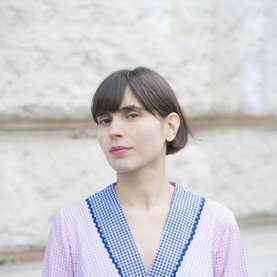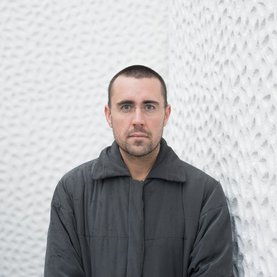ADS12: Personals
Jump to
ADS12 have been exploring the growing stresses on our mental lives through the estrangements of technology, emphasising the importance of architecture in addressing our well-being. Last year in ‘Glass-friends’ (2023–24) we surveyed spatial scenarios of multispecial companionship with artificial entities and diminishing haptic experiences. In 2024/25, ‘Personals’ will explore how we characterise and broadcast ourselves and our spaces in a new era of personal and virtual empowerment.

The AIDS Memorial Quilt laid out on the Ellipse Washington D.C. in 1988. Source: National Park Service
Studio Tutors: Pa.LaC.E: Valle Medina & Benjamin Reynolds
Role/Play
We are at a moment where recording devices and public platforms for self-expression are more accessible as ever. The confluence of more affordable technologies of capture and the free use of broadcasting platforms has come at the expense of our privacy and data, resulting in public processes of self-development and personal characterisation. This year in ADS12 we want to map the therapeutics of self-actualisation as it is aided by technology, together with the ways individualism might help produce supportive spaces and community.

@shirokumatyandaisuki cosplaying as a hoarder. Source: @shirokumatyandaisuki/TikTok
After years of undocumented and thinly veiled discrimination, many of us have been led to internalise negative beliefs about our capabilities and self-worth. This has affected an individual’s capacity for self-realisation. Now, with new tools of capture – and the potentials of physical and virtual augmentation – we are witnessing a generational project of sublimating those doubts. This is evident in the channelling of negative emotions into creative outlets, and the finding of purpose in a world that carries the baggage of unjust histories and social hypocrisies. Individuation is a process through which someone is both integrated in a collective, but also highly unique. It is often linked to internal and social conflicts and is manifested in struggle. Many of the allowances we’re afforded today are thanks to the social justice movements of the late 20th century, which advocated for each individual as a viable social subject. Activists such as those on the frontline of the HIV/AIDS epidemic helped to destigmatise sufferers by adopting slogans like ‘Positive is Not Negative’ and staging ‘die-ins’ to make themselves heard by government and the general public.
In 2024/25, the studio wants to leverage those technologies that facilitate transgressions of social norms, allow for radical individual characterisation, and can develop spaces of ‘individuated collectivity’. Spaces in which an individual can advocate for their own interests while also seeking to shape broader social movements. We will pay attention to two aspects: the durational processes of individuation; and the physical and virtualised forms of the public Self.

Left: “MakeupWheel”: a make-up set integrated as a new element in a car. Source: flickr.com; Right: Individual digital avatars for “NewJeans - The 1st EP”. Source: Reddit
Endure
While individuation can take the form of ethical gestures, political objectives, or legal acts, at its core it requires a bravery in declaring one’s own reality as alienating. For historically marginalised groups to attain social, political, or legal legibility it often took long-term critical reforms to the concept of identity. For example, it took the civil rights movement in the United States 100 years to establish racial segregation was unconstitutional. So, this year, ADS12 will also design with a special attention to the notion of time within the individuation process, bearing in mind that the process of ‘defamiliarising’ yourself from a context carries the potential for both gains and losses. That is, becoming socially defined as part of a group can come at the expense of being recognised as an individual. In this way, ADS12 wants to use the year as an architectural sandbox to disentangle personal realities from the status quo in order to also accelerate potential change beyond the individual.

The door to 'The Gateways' a social club that also acted as safe-haven for lesbians that also offered affordable housing throughout the 20th Century. Source: Historic England
Costume
‘Personals’ will explore the therapeutic possibilities of individuation. We will examine how an expression of the Self – ideologically and/or physically – can perform a form of healing. Knowing that one is able to both identify as an individual, and belong to a collective, can give great comfort for those whose rights and freedoms have been historically limited, impeding their chances to pursue self-actualisation. one positive aspect of digital platforms is that in searching for information, one can easily unearth allegiances with others.
Online, we can adopt non-normative identities and even engage in the construction of a character through which we live, interact, protect, and carry through distant digital worlds. Gamers first introduced the possibilities of roleplaying in off-screen environments through unabashed fandom, cosplaying, and strong social allegiances with fellow devotees. Being able to befriend other individuals with finely tuned personal identities has led to incredibly powerful social alliances, such as the punk movement or LARP (Live Action Role-Playing) communities.
To what degree can we transgress archaic social structures, political exclusion and race-, sexual- and class-based norms through the liberating potentials of personal shapeshifting? What forms of resistance are available at the level of our bodies? And also might be capable of being scaled-up to architecture? Can architecture take cues from the way many layers – sometimes even contradictory layers – can be superimposed through costume or AR filters, allowing shapeshifting, hiding, anonymity, or impermanence? Can architecture be a temporary, but stable, host for a pre-existing natural impermanence, including the seasons, other biological cycles, darkness and light, abundance and scarcity?

Left: Winding stream party, Gyeongju-Poseokjeong, Korea. Source: Wikipedia; Right: Ancient Japanese depiction of the “winding stream party”: a collective game for floating wine glasses. Source: collections.mfa.org
Bots
Despite the internet being home to vibrant communities and a facilitator of their offline gatherings, we are in the midst of witnessing the de-characterisation of the internet. Not only is the neutrality of the internet at stake, through the eradication of privacy and the funnelling of searches toward paid advertisers, but also the concept of dead internet theory suggests we are only interacting with bots. With these bots speaking to other bots in an endless regurgitative loop. The triumph of a globally–scaled communication platform is at risk of being profit-engineered to the point of obscuring the identity, bravery, and uniqueness of the fragile communities that call it home.
‘Personals’ will also take aim at AI. In principle, this technology exists as the median status quo, unless otherwise prompted, and has a huge potential to impact the formation of personhood. The wonder of AI has yet to leave its wider mark on communities and it poses a risk in those societies in which convenience is championed. It is likely we will see a boom in the definitions of human identification within post–labour societies in which the void of work is filled by social associations of leisure and care. If cognitive labour is excised from the brain through the use of AI, however, what will become of an individual’s personal agency?
My Private Clinic
The online rise of the domestic as an extension of a personal inner sanctum has given the home a newfound role in the formation of the individual. The domestic realm can be seen as deinstitutionalised safe space; a stage where the audience can be switched off; a club where members ‘sign up’ and ‘belong’; and a vault to protect virtual belongings. Because the tools designed for professionals are now accessible to the consumer, personal rooms have become DIY portals. For example, in the case of advising on healthcare, friends and visitors might replace healthcare professionals, undermining legally–defined clinical structures (such as the hippocratic oath); familiar domestic self-care objects, such as mirrors, cosmetics, and herbal remedies might sit alongside hormone monitoring devices, microbiome-enhancing products, and blood transfusion pumps. While such a collusion may add unnecessary risks, it also creates new dimensions of care that are unattainable within health infrastructures in crisis.

Left: Jones Benally, a healer on the Navajo Reservation in Arizona for more than 75 years, heals his patients’ bodies and minds to relieve pain and stress. Source: nationalgeographic.pt; Right: Elke Krystufek’s 1994 performance ‘Satisfaction’, challenged conventional representations of the female body turning the personal space towards a public audience
As a profession, it seems architecture has deviated from classical notions of beauty to permit the wound as an acceptable architectural aesthetic. Raw materials, repurposed structures, and exposed services signal the emergence of the ‘undressed wound’ as a permissible aesthetic, which marries cost-effective construction with climate-conscious materiality. Could this architectural movement also be seen as allied to the healing of living beings? Can structures, like human tissue, be reshaped, reformed, or sutured together to allow for new forms of life? Instead of hiding pasts, or the shame felt of an undressed structure, could an architect performing sutures leave scars as a signal of resilience?

Left: Lacaton and Vassal’s stripping of Palais de Tokyo, Paris which opened in 2001. Source: ArchDaily; Right: Dan Flavin’s remodelling with light, of Santa Maria Annunciata in Chiesa Rossa, Milan. Source: italics.art
Cerebral Triggers
This year ADS12 will produce ‘Personals’: architectures that act as virtual and material mirrors of identity. We will collectively reflect on forms of bewilderment, stress, and disarray that we embody today. We will discover personal space as the bearer of new social relations of dependence and independence between people, including alternate family structures, and functions, such as subverting private spaces to make them open infrastructures for shared identities. To explore the capacity of personal space we will work in two ephemera; the presence of noise as something to be constructed and listened to; and with the olfactory field. Both experiences will act as cerebral triggers to construct spaces that inscribe and reactivate a personal politics within shifting and alienating contexts. Finally, we will use terms like wenxiang or mon-koh, used by Chinese and Japanese speakers respectively, which refer to ‘listening to incense’, as ways to allow us to bridge the senses.
High Holdings
In 2024/25, “Personals” will again be hosted as https://personals.ho.ldin.gs/ within High Holdings (http://ho.ldin.gs/) – an environment for generating architectural discourse that address the unfolding depictions of the world, which may appear unrecognisable, but are truly products of terrestrial occupation. By prioritising the sovereignty of the architectural idea, High Holdings continues to explore the growing distance between information and (over–) looking; complexity and (mis–)understanding; contribution and (non–)participation. Previously, ‘Glass-friends’ (2023–24) surveyed the spatial scenarios of multispecies companionship with artificial entities, Limits’ (2022–23) surveyed the boundaries of our senses as a species; ‘Take-away’ (2021–22) used deprivation as a productive strategy; ‘Melee’ (2020–21) developed projects as plenitudes; ‘Sight/Seeing’ (2019-20) put the conspicuity of the Image on trial; and “CHRONOCOPIA” (2018-9) explored how to characterise time within the architectural project in order to perceive the speed of the present.
Tutors:
Pa.LaC.E
https://palace.studio/
@pa.lac.e
Valle Medina’s interest is formed at the intersection of lyrical substances and mental life. Benjamin Reynolds surveys the spatial and temporal breadths of modern will. They are co-founders of the architecture practice Pa.LaC.E (https://palace.studio/; @pa.lac.e). Pa.LaC.E has been the recipient of the 50th annual Shinkenchiku Award first prize in Tokyo (JP), Lausanne Gardens (CH), among other international prizes and their work has been shown at ICA (UK), Van Abbemuseum (NL), La Becque (CH), Venice Biennale of Architecture (IT), the Centre of Contemporary Culture of Barcelona (ES), Ausstellungsraum Klingental in Basel (CH), and the Architecture Foundation in London (UK). Pa.LaC.E's works have been published in Sternberg Press (DE), Texte Zur Kunst (DE), e-Flux Journal (US), Ecocore (UK) and Volume (NL). At the Royal College of Art they lead the project “High Holdings” (https://ho.ldin.gs/; @rca.ads.12). High Holdings is a refuge to form architecture via our mental life within technological estrangement. It explores the growing distance between information and (over-)looking; complexity and (mis-)understanding; contribution and (non-)participation. For a full brief, please refer to the link in bio of @rca.ads12.

